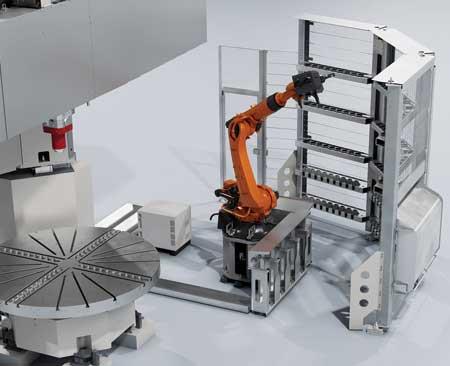
"Although the Dörries VT 28 builds on the robust and durable features of the VCE series, we have brought it up to the latest state of technology," said Heiko Quack, Sales Manager of Starrag's LPMS division.

The Dörries VT 28 is equipped with a solid, low-vibration table base made of special concrete (UHPC) and features flexible robot tool handling, digital IFM sensors and a high-pressure coolant supply (350 bar) for machining difficult-to-cut materials such as heat-resistant superalloys or titanium.
Starrag has introduced the Dörries VT 28 vertical turning lathe, which replaces the Dörries VCE 2800. The first of a new series, it combines the technology of the VCE series with new, innovative solutions.
While the Dörries VT 28 was developed to meet current market demands, it is specially designed for precise and dynamic machining in the wind power and aircraft industries.
Heiko Quack, LPMS Sales Manager, said: "The Dörries VT 28 builds on the robust and long-lasting features of the Dörries VCE series, but we have innovated it from the ground up and brought it up to the latest state of technology. The new machine has been completely redesigned and is engineered for multifunctional, high-precision and flexible pre-machining and finishing, for example for components such as planetary carriers and large engine housings. It combines state-of-the-art technologies, power and torque as well as highly flexible interchangeable systems."
The direct drive allows for dynamic positioning and fast start-up, thus reducing processing times and, as a result, the costs per component. Components weighing up to 37,479 lbs. (17 tons) with a maximum diameter of 11" (2.8 meters) and a height of 104" (2.65 meters) can be processed on the rotary table of the Dörries VT 28.
Starrag continues to use wear-free, hydrostatic guides in all linear axes to dampen vibrations and help ensure a high level of accuracy. The hydrostatic system reacts robustly to temperature fluctuations and changes in viscosity, thus enabling maximum precision.
A special concrete is used for the table base: the material of choice was Ultra High Performance Concrete (UHPC), which is characterized by high strength and durability, and is superior to a cast substructure in terms of damping properties and temperature stability, the company reported.
"Despite the extensive technical innovations, Starrag has reduced costs and delivery times by introducing new assembly processes and standardizing them to a high degree, while still allowing flexible adjustments," noted Quack. "As long as we cover significantly more than 90% of all requirements as standard, we can offer attractive prices. Our aim is to maintain a high level of standardization without losing sight of customer-specific solutions."
The Dörries VT 28 offers an option for compact floor installation, whereby the foundation base is only above the floor, resulting in lower foundation costs. The base of the column is part of the foundation, which leads to increased rigidity due to the reduced lever arm on the fastening forces.
The intelligent mix of materials helps ensure optimum static and dynamic rigidity. This is reflected in high chip volume, enhanced surface results, greater accuracy and reduced tool wear. The table base is made of the composite material UHPC, which offers increased damping, thermal stability and a low CO2 footprint. The uprights and cross beams are made of steel to provide maximum rigidity, while the cast iron cross slide offers high material damping. The forged RAM provides rigidity and strength.
The number of components along the kinematic chain has been reduced. Two-stage gears in the table and milling drive have been replaced by direct drives, resulting in increased dynamics and positioning accuracy as well as improved interpolation processing.
These innovations can also reduce maintenance and servicing costs. The RAM cross-section is larger (12.2" x 12.2" vs. 11.8" x 9.8"/310 mm x 310 mm vs. 300 mm x 250 mm) with the same plunge diameter (15"/380 mm) and a longer Z-stroke (68.9 mm vs. 59.1"/1,750 mm vs. 1,500 mm). The master head concept for attachments enables the milling drive and tool interface to be decoupled and provides additional protection for the milling drive against collisions.
Compared to its predecessor, the Dörries VT 28 offers 7.9" (200 mm) more turning height and has a powerful, water-cooled direct drive in the table with 131 HP (98 kW), 250 RPM and a constant 7,376 ft-lbs. (11,000 Nm) up to 85 RPM. The drive is free of gear losses, requires only minimal lubrication of the bearings and is maintenance-free. The maximum positioning accuracy of 0.001° is suited for interpolation machining, such as thread molding.
Modern hydrostatics help ensure high removal rates and precision. The fully enclosed RAM is equipped with progressive flow control for hydrostatics and offers maximum rigidity and accuracy. The gap remains constant even under load, which provides greater robustness compared to flow control valves, the company reported. These systems are practically wear-free.
The machine is designed for high-pressure coolant supply up to 350 bar (optional) and has controlled nozzles for optimum chip breaking in titanium and Inconel applications. Flexible handling of devices and tools is made possible by industrial robots that offer maximum reliability. Loading and unloading of tools during the machining operation minimizes downtimes. Available as standard are 108 tool positions and up to 7 attachment units.
For more information contact:
Starrag USA Inc.
Skyport Business Park
2379 Progress Drive
Hebron, KY 41048
859-534-5201
ussales@starrag.com
www.starrag.com